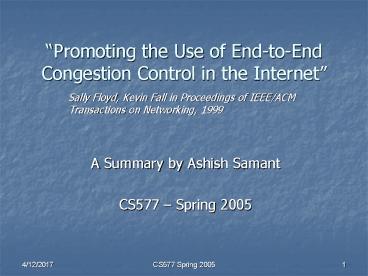- PowerPoint PPT Presentation
Title:
Description:
Promoting the Use of End-to-End Congestion Control in the Internet Sally Floyd, Kevin Fall in Proceedings of IEEE/ACM Transactions on Networking, 1999 – PowerPoint PPT presentation
Number of Views:20
Avg rating:3.0/5.0
Title:
1
Promoting the Use of End-to-End Congestion
Control in the Internet
- Sally Floyd, Kevin Fall in Proceedings of
IEEE/ACM Transactions on Networking, 1999 - A Summary by Ashish Samant
- CS577 Spring 2005
2
Outline
- Need for end-to-end congestion control
- Unfairness, Congestion Collapse
- Per flow based scheduling Vs Congestion Control
mechanisms at the router - Identifying candidate flows for regulation
- Other incentives for flows
3
Introduction
- End hosts/applications may not use end-to-end
congestion control schemes. - Problem - This may lead to congestion collapse
and unfairness, in times of congestion. - Solution Isolate ill-behaving flows, use
per-flow based queuing at routers. - This may not be sufficient !!
4
Introduction . continued
- Authors suggest -
- Routers must support congestion control and
regulate high-bandwidth flows. - Routers must regulate best effort flows that
- are TCP-Unfriendly,
- unresponsive to congestion,
- use disproportionate bandwidth.
5
Introduction . continued
- Unresponsive flows cause two problems
- - Unfairness well-behaved flows may suffer
bandwidth starvation because unresponsive flows
do not react to congestion. - - Congestion collapse the scarce bandwidth
of the network is consumed by packets from
unresponsive flows, that will be discarded
sooner or later.
6
Experimental Setup
7
Unfairness 3 TCP, 1 UDP flow, FCFS
8
Fairness 3 TCP, 1 UDP flow, WRR
9
Congestion Collapse 3 TCP, 1 UDP flow, FCFS
10
Congestion Control 3 TCP, 1 UDP flow, WRR
11
Congestion Control 3 UDP, 1 TCP flow, WRR
12
Identifying non TCP-Friendly Flows
- TCP Friendly Flow arrival rate does not exceed
that of any other TCP conformant flow. - Maximum sending rate for a TCP Friendly flow
- T - sending rate p - packet drop rate B
max packet size R minimum RTT - Actual rates will be less than T.
13
Identifying non TCP-Friendly Flows
- Limitations
- Inconsistencies in finding packet size, round
trip time. - Measurements should be taken over a long
interval of time. - Bursty packet drops.
- Router Response
- Routers should freely restrict the bandwidth of
non - TCP Friendly flows.
14
Identifying Unresponsive Flows
- TCP Friendly test cannot be used at routers that
are unable to determine packet sizes and RTTs. - If packet drop rates increase by x , the arrival
rate should drop by vx . - When packet drop is constant, no flow will be
identified as unresponsive.
15
Identifying Unresponsive Flows
- Limitations
- Packet drop may be because of various reasons,
hard for flows with variable demand. - Flows might be tempted to start with a higher
initial bandwidth demand. - Response
- Actively regulate the bandwidth of unresponsive
flows in times of congestion.
16
Identifying flows using disproportionate flows
- Flows that require larger bandwidth than other
flows that reduce their demand. - These might be TCP friendly but still be
disproportionate. - Arrival rate lt log(3n) / n n no of flows
- Arrival rate lt c / vp p pkt drop rate
- c some constant
17
Comments and Conclusion
- Alternate approaches
- - use schemes that are a mix of FCFS and
per-flow based approach ( FCFS scheduling with
differential dropping ). - - pricing incentives.
- granularity of flows
- - apply fairness tests to single/aggregate of
flows. - min-max fairness measure
- - need to look at the entire path, all the
congested links.
18
Comments and Conclusion continued
- Breaking a TCP connection, increased local
throughput but also increases global packet drop
rate.
19
Derivation of TCP Friendly Rate
- Once congestionWindow gt W a packet is dropped
and the congestion window is halved. - As long as congestionWindow lt W window is
increased by 1, per RTT - W/2 (W/21) (W/22) W 3/8W2
- gt per packet drop max 3/8W2 packets are
sent - gt max packet drops lt 1/(3/8W2)
20
Derivation of TCP Friendly Rate Continued
- Max bytes transferred per cycle of steady state
- Total packets sent Avg. packet Size
- Avg Round Trip Time
- ( Total packets sent 0.75W )
- gt (0.75 W B) / R
- gt































